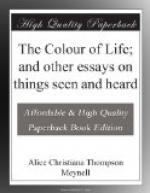On the other hand, Italians are expressive. They are so possessed by the one thing at a time as never to be habitual in any lifeless sense. They have no habits to overcome by something arbitrary and intentional. Accordingly, you will find in the open-air theatre of many an Italian province, away from the high roads, an art of drama that our capital cannot show, so high is it, so fine, so simple, so complete, so direct, so momentary and impassioned, so full of singleness and of multitudinous impulses of passion.
Signora Duse is not different in kind from these unrenowned. What they are, she is in a greater degree. She goes yet further, and yet closer. She has an exceptionally large and liberal intelligence. If lesser actors give themselves entirely to the part, and to the large moment of the part, she, giving herself, has more to give.
Add to this nature of hers that she stages herself and her acting with singular knowledge and ease, and has her technique so thoroughly as to be able to forget it—for this is the one only thing that is the better for habit, and ought to be habitual. There is but one passage of her mere technique in which she fails so to slight it. It is in the long exchange of stove-side talk between Nora and the other woman of “The Doll’s House.” Signora Duse may have felt some misgivings as to the effect of a dialogue having so little symmetry, such half-hearted feeling, and, in a word, so little visible or audible drama as this. Needless to say, the misgiving is not apparent; what is too apparent is simply the technique. For instance, she shifts her position with evident system and notable skill. The whole conversation becomes a dance of change and counterchange of place.
Nowhere else does the perfect technical habit lapse, and nowhere at all does the habit of acting exist with her.
I have spoken of this actress’s nationality and of her womanhood together. They are inseparable. Nature is the only authentic art of the stage, and the Italian woman is natural: none other so natural and so justified by her nature as Eleonora Duse; but all, as far as their nature goes, natural. Moreover, they are women freer than other Europeans from the minor vanities. Has any one yet fully understood how her liberty in this respect gives to the art of Signora Duse room and action? Her countrywomen have no anxious vanities, because, for one reason, they are generally “sculpturesque,” and are very little altered by mere accidents of dress or arrangement. Such as they are, they are so once for all; whereas, the turn of a curl makes all the difference with women of less grave physique. Italians are not uneasy.
Signora Duse has this immunity, but she has a far nobler deliverance from vanities, in her own peculiar distance and dignity. She lets her beautiful voice speak, unwatched and unchecked, from the very life of the moment. It runs up into the high notes of indifference, or, higher still, into those of ennui, as in the earlier scenes of Divorcons; or it grows sweet as summer with joy, or cracks and breaks outright, out of all music, and out of all control. Passion breaks it so for her.




